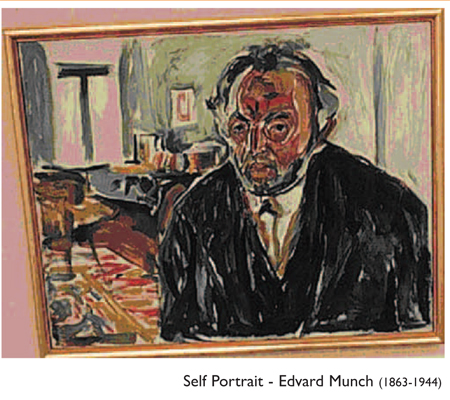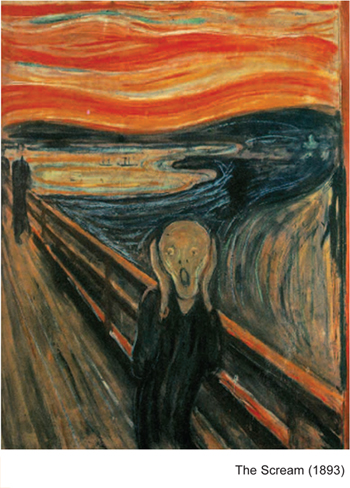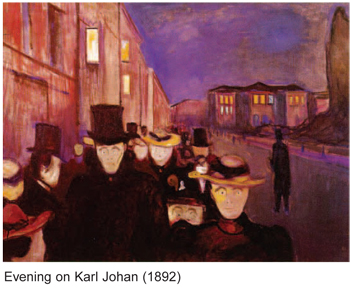
 Most people are familiar with "The Scream,"
Edvard Munch's most famous painting. As powerful
as it is, this painting is only one of over a thousand
that he created in his long career. Individuals
traveling to Oslo can view his prolific body of work,
as only a small percentage of his original art exists
outside of Norway. Munch, a native Norwegian,
never married and thought of his paintings as his
children and seldom parted with them. Therefore,
most were not available for viewing until he passed
away. When he died in 1944 at his estate outside Oslo, he was 80 years old. The authorities found
locked in his house - a collection of 1,008 paintings,
4,443 drawings, 15,391 prints, 6 sculptures, plus
numerous woodcuts and more. Before his death
Munch had bequeathed his oeuvre to the city of
Oslo. The city built the Munch Museum to house the
major part of this collection. A smaller group can be
viewed at the National Gallery in Oslo.
Most people are familiar with "The Scream,"
Edvard Munch's most famous painting. As powerful
as it is, this painting is only one of over a thousand
that he created in his long career. Individuals
traveling to Oslo can view his prolific body of work,
as only a small percentage of his original art exists
outside of Norway. Munch, a native Norwegian,
never married and thought of his paintings as his
children and seldom parted with them. Therefore,
most were not available for viewing until he passed
away. When he died in 1944 at his estate outside Oslo, he was 80 years old. The authorities found
locked in his house - a collection of 1,008 paintings,
4,443 drawings, 15,391 prints, 6 sculptures, plus
numerous woodcuts and more. Before his death
Munch had bequeathed his oeuvre to the city of
Oslo. The city built the Munch Museum to house the
major part of this collection. A smaller group can be
viewed at the National Gallery in Oslo.  As one might surmise, Munch's gloomy paintings
are indicative of an unhappy life. He wrote in a
private diary, of which he kept many, "I inherited two
of mankind's most frightful enemies - the heritage of
consumption and insanity - illness and madness and
death were the black angels that stood at my cradle."
The second of five children, his thirty-year old
mother died of tuberculosis when he was only five
years old. His father who was left to care for the
children was a gloomy, religious fanatic from whom
Edvard inherited a tremendous sense of guilt. As a
young boy Edvard exhibited artistic talent but was a
sickly child who couldn't attend school regularly. He
adored his older sister Sophie whose death, nine
years after his mother's, when she was fifteen years
old scarred him for life.
As one might surmise, Munch's gloomy paintings
are indicative of an unhappy life. He wrote in a
private diary, of which he kept many, "I inherited two
of mankind's most frightful enemies - the heritage of
consumption and insanity - illness and madness and
death were the black angels that stood at my cradle."
The second of five children, his thirty-year old
mother died of tuberculosis when he was only five
years old. His father who was left to care for the
children was a gloomy, religious fanatic from whom
Edvard inherited a tremendous sense of guilt. As a
young boy Edvard exhibited artistic talent but was a
sickly child who couldn't attend school regularly. He
adored his older sister Sophie whose death, nine
years after his mother's, when she was fifteen years
old scarred him for life.
Out of his family of seven, his parents and five
children, only Edvard and a sister, who also never
married, lived into old age. Fear of his families
afflictions had made him vow early in life never to
marry and his love life was equally as tragic as his
childhood. Two painful love affairs left him fascinated
by the theme of a forlorn man and a dominating
woman. He represented women as either frail,
innocent sufferers or as vampires. Not surprisingly
analysts have theorized this reflects his sexual anxiety.
Art was his therapy for his unresolved mental issues.
"Art must be created with your own blood."
Munch was a major contributor to the
Expressionist Art movement of the early 20th
century, but he shunned being revered as a
master or a mentor and preferred to standalone.
Starting painting at 17, he spent 20
years predominantly in Paris and Berlin where
he was influenced by the techniques of Manet,
Monet, Degas, Gauguin, and other great
masters. But Munch wished to paint emotion.
"It's not the chair that should be painted, but
what a person has felt at the sight of it." He
developed an expressive and psychologically
powerful style - painting what he had seen
and never looking at it again. "I do not paint
what I see, but what I saw." As an adolescent
he was part of a bohemian group that were the
forerunners of the Existentialists - led by Hans
Jaeger. They spent hours discussing
intellectual and social liberation and this was
reflected in his painting.
The playwright Henrik Ibsen, although
thirty years older, was also an innovator in
Oslo and Munch painted scenery for several
of his plays, "Ghost, Peer Gynt" and "Heda
Gabler." Many scholars feel there is an
intense literary and mystical approach to art
that is particular to Scandinavia. Munch's
paintings are full angst - many of them
depicting his sister Sophie's illness and last
days. While dying Sophie asked to be lifted
out of bed and placed in a chair. Munch
kept that chair until his death. It is now in
the Munch Museum.
Eventually, his excessive drinking became
uncontrollable and by the fall of 1908, he
collapsed while hearing hallucinatory voices and
suffering paralysis on his left side. A friend
convinced him to check into a sanitarium. He
emerged months later with some semblance of
renewed mental stability and the determination
to look on the bright side of life. Retreating to his
eleven-acre estate outside of Oslo, he became
increasingly isolated for the last 27 years of his
life. Compared to the rest of his life, this was
relatively tranquil and it was reflected in his work.
He kept his distance even as he was declared
Norway's National Artist. His later works were
not as tortured and full of angst as his earlier
works and many art historians think that
therefore they are not as powerful. Increasingly
however, many art lovers are returning to these
later works with renewed enthusiasm.
 Munch's "The Scream", painted in 1893, (originally
called "Despair") is one of the world's most recognized
paintings. It is said to be the icon of Modern Art, as the
Mona Lisa was an icon for the Renaissance. Where the
Mona Lisa depicts serenity and self-control, Munch's
masterpiece depicts the uncertainty and anxiety of the
modern age. The painting is a sexless creature shrieking
in terror. Munch said he recreated a vision that had seized
him one evening as he walked home with two friends at
sunset, when he heard "a huge endless scream course
through nature" and the "air turned to blood." He made
two oil paintings, two pastels, and numerous prints of
this image. One of the oil paintings belongs to Oslo's
National Gallery and the other to the Munch Museum.
Both have been stolen in recent years. The one in the
Norwegian National Gallery, considered to be the most
significant one, was stolen in 1994 as the Winter Olympic
Games began in Norway. It was recovered later that year,
undamaged, and three Norwegians were arrested. The
other oil original was ripped off the wall of the Munch
Museum in August of 2004, by two hooded and armed
men - as a gallery of stunned visitors watched. Amazingly,
there was very little security. It was recovered two years
and nine days after the theft. Arrests were made and the
thieves charged. This canvas did sustain damage too
extensive to be repaired completely but it has been put
back on display under high security.
Munch's "The Scream", painted in 1893, (originally
called "Despair") is one of the world's most recognized
paintings. It is said to be the icon of Modern Art, as the
Mona Lisa was an icon for the Renaissance. Where the
Mona Lisa depicts serenity and self-control, Munch's
masterpiece depicts the uncertainty and anxiety of the
modern age. The painting is a sexless creature shrieking
in terror. Munch said he recreated a vision that had seized
him one evening as he walked home with two friends at
sunset, when he heard "a huge endless scream course
through nature" and the "air turned to blood." He made
two oil paintings, two pastels, and numerous prints of
this image. One of the oil paintings belongs to Oslo's
National Gallery and the other to the Munch Museum.
Both have been stolen in recent years. The one in the
Norwegian National Gallery, considered to be the most
significant one, was stolen in 1994 as the Winter Olympic
Games began in Norway. It was recovered later that year,
undamaged, and three Norwegians were arrested. The
other oil original was ripped off the wall of the Munch
Museum in August of 2004, by two hooded and armed
men - as a gallery of stunned visitors watched. Amazingly,
there was very little security. It was recovered two years
and nine days after the theft. Arrests were made and the
thieves charged. This canvas did sustain damage too
extensive to be repaired completely but it has been put
back on display under high security.